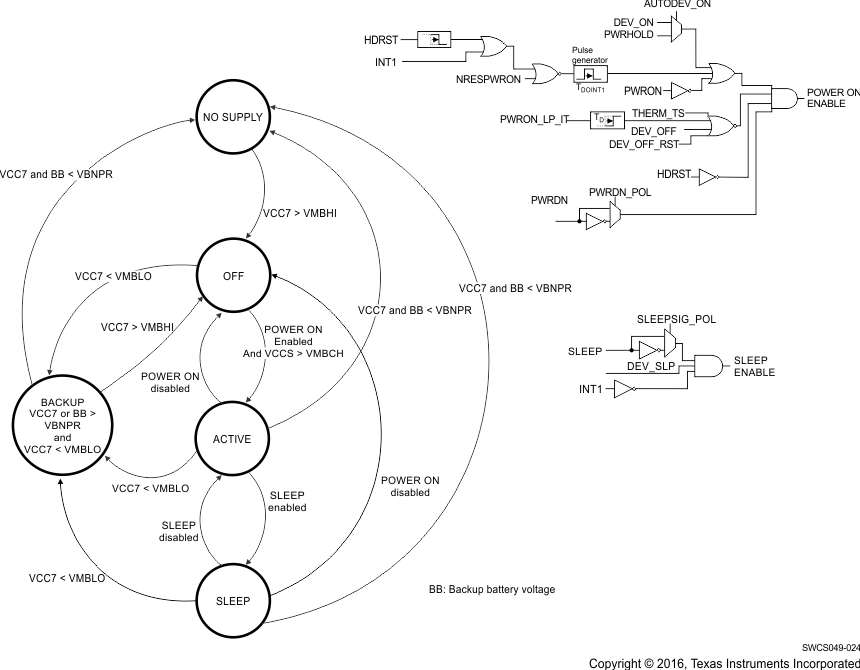SWCS049S June 2010 – August 2018 TPS65911
PRODUCTION DATA.
- 1Device Overview
- 2Revision History
- 3Device Comparison Table
- 4Pin Configuration and Functions
-
5Specifications
- 5.1 Absolute Maximum Ratings
- 5.2 ESD Ratings
- 5.3 Recommended Operating Conditions
- 5.4 Thermal Information
- 5.5 Electrical Characteristics: I/O Pullup and Pulldown
- 5.6 Electrical Characteristics: Digital I/O Voltage
- 5.7 Electrical Characteristics: Power Consumption
- 5.8 Electrical Characteristics: Power References and Thresholds
- 5.9 Electrical Characteristics: Thermal Monitoring and Shutdown
- 5.10 Electrical Characteristics: 32-kHz RTC Clock
- 5.11 Electrical Characteristics: Backup Battery Charger
- 5.12 Electrical Characteristics: VRTC LDO
- 5.13 Electrical Characteristics: VIO SMPS
- 5.14 Electrical Characteristics: VDD1 SMPS
- 5.15 Electrical Characteristics: VDD2 SMPS
- 5.16 Electrical Characteristics: VDDCtrl SMPS
- 5.17 Electrical Characteristics: LDO1 and LDO2
- 5.18 Electrical Characteristics: LDO3 and LDO4
- 5.19 Electrical Characteristics: LDO5
- 5.20 Electrical Characteristics: LDO6, LDO7, and LDO8
- 5.21 Timing and Switching Characteristics
-
6Detailed Description
- 6.1 Overview
- 6.2 Functional Block Diagram
- 6.3 Power Reference
- 6.4 Power Resources
- 6.5 Embedded Power Controller (EPC)
- 6.6 PWM and LED Generators
- 6.7 Dynamic Voltage Frequency Scaling and Adaptive Voltage Scaling Operation
- 6.8 32-kHz RTC Clock
- 6.9 Real Time Clock (RTC)
- 6.10 Backup Battery Management
- 6.11 Backup Registers
- 6.12 I2C Interface
- 6.13 Thermal Monitoring and Shutdown
- 6.14 Interrupts
- 6.15 Register Maps
-
7Applications, Implementation, and Layout
- 7.1 Application Information
- 7.2 Typical Application
- 7.3 Power Supply Recommendations
- 8Device and Documentation Support
- 9Mechanical, Packaging, and Orderable Information
Package Options
Mechanical Data (Package|Pins)
Thermal pad, mechanical data (Package|Pins)
Orderable Information
6.5.1 State Machine
The EPC supports the following states:
- NO SUPPLY: The primary battery supply voltage is not high enough to power the VRTC regulator. A global reset is asserted in this case. Everything on the device is off.
- BACKUP: The primary battery supply voltage is high enough to enable the VRTC domain but not enough to switch on all the resources. In this state, the VRTC regulator is in backup mode and only the 32K oscillator and RTC module are operating (if enabled). All other resources are off or under reset.
- OFF: The primary battery supply voltage is high enough to start the power-up sequence, but device power on is not enabled. All power supplies are in the OFF state except VRTC.
- ACTIVE: Device POWER ON enable conditions are met and regulated power supplies are on or can be enabled with full current capability.
- SLEEP: Device SLEEP enable conditions are met and some selected regulated power supplies are in low-power mode.
Figure 6-1 shows the transitions for the state machine.

NOTE:
PWRHOLD enables power-on unless the pin is programmed as GPI.